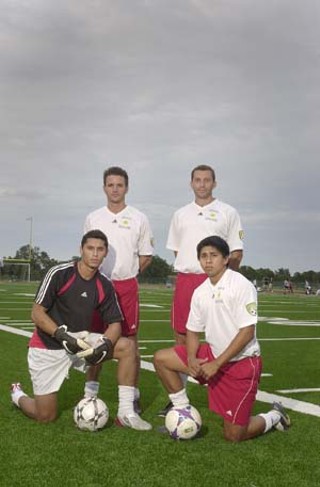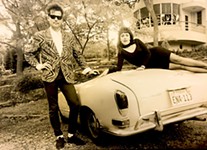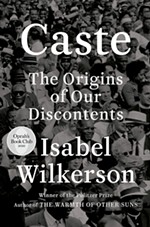Weathering the Storm
Austin's amateur soccer team searches for steady footing
By Joe O'Connell, Fri., June 22, 2007

A soccer ball slices through the steamy June sky at Bohls Park near downtown Pflugerville. Nearby, a white-haired jogger, looking lean and fit, ambles past on the trail. "Somebody for development, Jaime?" an Austin Lightning player says with a smile to coach Jaime Mimbela and takes a sip from a very necessary water bottle. Close by, several children – "Not ours," Mimbela quickly responds – kick about their own soccer ball in another corner of this tree-draped neighborhood park that today, amid a multicolored jungle gym and in view of towering McMansions, serves as home base for perhaps Austin's best-kept sports secret.
A ragtag member of soccer's Premier Development League, the Lightning is among 63 teams of top amateurs, including college players honing their skills during the summer months, experienced players dreaming of playing professionally for Major League Soccer, and the war-weary veterans who've flirted with the big time and now are content as player/coaches. Sound like the classic movie script about the sports underdogs with an impossible goal and unending desire? Exactly. If this were baseball, the Lightning would be the minor-league "You've got to get out of the way," Mimbela says as Nick "Bazooka" Torres of Mexico sinks his foot into the ball. Mimbela, who came to Austin from Peru, quickly made a name for himself on the local soccer scene, first as a player, later as a coach. His two high school-age sons are now the youngest Lightning players. The Lightning began as a PDL team in Lafayette, La., then moved to Austin early in the decade. Mimbela and friends bought the team in 2003. "I like youth, and I like to develop talent," he says. "That's what this league is all about."
The summer season's first game drew more than 800 fans to House Park, despite the game location being switched with only a week's notice (the Lightning were originally scheduled to play their home games at the Toney Burger Activity Center). But when it rains, House Park is shut down to keep from damaging the field. And it's rained a lot lately on the Lightning. That prompted a move to Vista Ridge High School, where the turf could conceivably withstand anything. But when the rains came this past Friday, they knocked out power to the field and forced a cancellation. The resilient Lightning snapped back and were on the field for Saturday's game vs. the Baton Rouge Capitals. "It takes an incredible amount of work to get it done," operations manager and minority owner Hugh Bender says of keeping the business going, "but we're pulling it off so far."
It could be a matter of good timing for the franchise, which comes 20 years into the era of the soccer mom escorting her kids to fields much like that at Bohls Park and watching as the tykes learn the intricacies of a sport that has long been the dominant "football" of the world but has been slow to gain a foothold in the United States. "It's the biggest youth sport in the country," says Bender, who grew up in St. Louis, where the sport was already booming in the 1970s. "At high school it drops off, something that I attribute to my generation not realizing how big it is around the world." The sport did make a large leap in popularity in 1994 with the staging of the World Cup in the USA, an event that came with the promise that a professional league would soon form (MLS started two years later). That World Cup set attendance records that have yet to be toppled. Today the great U.S. soccer hope is British soccer legend David Beckham, whose rock-star-like status, magnified by his role as the husband of Posh Spice, is coming to the MLS's Los Angeles Galaxy in July via a five-year contract said to total $250 million. That same month, popular forward Cuauhtémoc Blanco from Mexico City's Club America joins the Chicago Fire in a contract said to approach $2 million a year – more than all of his teammates combined. "Soccer is about to do an exponential jump in popularity around this country," Bender says.
"It is arising big time," says Mimbela, whose day job is in the semiconductors field. "Players are begging me to get on the roster." And the Lightning have proof that the dream can come true. Sonny Guadarrama played on the team briefly before being snapped up by Santos Laguna of Mexican professional soccer's first division. His brother Willy was taken by the Kansas City Wizards of the MLS, where he joined a third former Lightning player, A.J. Godbolt. This year, 33 former Premier Development League players were picked up in the MLS SuperDraft, including five in the first round and one as the overall third pick.
In the end, the Lightning's future is forever tied to the Dream with a capital "D." Kevin Costner's world-weary Crash Davis – who described himself in the film as "the player to be named later" – had it in Bull Durham, and Lightning player/coach Beto Papandrea might not readily admit it, but that dream surely lurks for him as well. Blond, tanned, and a double for a younger Costner, Papandrea moved to Austin from Argentina at 18 for his father's work. He graduated from Kirby Hall and quickly moved up through the Texas soccer ranks, playing for the Austin Lone Stars and San Antonio Pumas, then semipro for the Milwaukee Rampage. Finally he got tryouts with the Miami Fusion and Dallas Burn. "It didn't work out," he says, a grin raising fine lines around his green eyes. Now 31, he knows what the teenagers and twentysomethings who make up most of the team don't. "Soccer, it's about what you have here," he says pointing at his head. "There's a lot of running, but without a brain, you've got nothing. I like that I can still run, that I can still compete with these young kids."
Papandrea points to Torres, the player dubbed "Bazooka," who, as if on cue, kicks the ball with laser precision. "If he gets a free kick, there's a 50-50 chance he'll score," Papandrea says. Indeed, for Torres, a 22-year-old Texan who recently graduated from the University of the Incarnate Word in San Antonio, soccer is deadly serious. Growing up in Portland, Texas, and attending Gregory-Portland High School, a school rich in football tradition, near Corpus Christi, he found sports was the answer for boredom, but by age 12, he'd given up all but soccer. "I'm pretty much peaking," he says. "In my eyes I have hope, but I'm not one to get caught up in that. I'm just trying to stay in shape. It's the same old story: Come on the field, put on your shoes, and have some fun. But you've got to have a dream, something to strive for." Mimbela spotted Torres' talent quickly, but the young player still had to prove himself. "The first day of training Beto didn't say a word to me, or even for the first week or two," Torres said. "But he started figuring out I could play, I could shoot, I could put the ball in the net. You have to prove yourself to them."
Torres soon may not be alone as a future superstar. Formerly known as Revolution, the youth team now known by the clunky title Dallas Texans of Austin have affiliated with the Lightning, in a move that would provide a feeder system, and the Lightning's separate U.S. Club Soccer team soon travels to Virginia Beach for competition. The result could be stronger and more plentiful players for the Lightning to choose from in the future. On the other end of the spectrum, the Lightning was scheduled this past Wednesday to play with Major League Soccer's Houston Dynamo, a team that Mimbela would love to affiliate with in the future. And there's talk of a female team as early as next season. It's all part of that decades-long change in U.S. perception of the sport. "When I came here, I was shocked to see how poor soccer was here," says Papandrea, who rues that his chances were hurt professionally back in the day because teams were seeking foreign players already seasoned with professional experience. "Now young kids see it as a real sport; they don't just see it as a hobby. U.S. soccer has a lot of a future."
Miguel Gallardo, at 22 the team's starting goalie, has the look of the golden boy to him. Call him Tim Robbins' Nuke Laloosh to Papandrea's Crash Davis. Gallardo came to the U.S. from Mexico at age 14 and played soccer at Westwood High School before going back home to play pro for the Tigres in Mexico. Does he want back in the bigs? "I'd be lying if I said no," says Gallardo, who works construction as a general contractor. "If the opportunity ever arose in the U.S. ..." His coaches and teammates are optimitistic that chance may come. "It's a lot of hard work," Gallardo says of being a goalie. "You have to work on your reflexes, and there's a lot of guessing, a lot of intuition. You have to not be afraid to get hurt every time you dive."
The Lightning is out to also prove itself to Austin, and Mimbela and company are dreaming big. They have their eyes on a permanent field – one used to shoot the television show Friday Night Lights was considered. Team owners would prefer one that offers the ability to sell beer during games, something verboten on public-school grounds. That could lead to beer sponsorships, which would keep the franchise on steady financial ground. Another effort is the creation of the Fanaticos, a seating section at games set aside for the loudest, most boisterous fans. At the same time, Bender sees the Lightning as a perfect form of family entertainment and envisions crowds in the thousands by next season.
Marcelino Uriarte, a St. Edward's grad born in Venezuela, sees the secret to the team as "three to four experienced players plus a lot of youth and energy." The 28-year-old says the difference between U.S. soccer and its South American counterparts is one of grace. In Venezuela, the emphasis is on technical precision; in the U.S., the game gets more physical. For the Lightning, that leads to some inconsistency in play that the experienced players seek to hammer out. He and Papandrea work the midfield. "Our job is to organize and distribute. We're more the heart, the base."
In the end, the Lightning is about heart. "We're not getting paid, so everybody still has a job or goes to school," Gallardo says. "It's not a profession, but it's the closest thing to it. It's a beautiful thing. You have to realize that on Sundays, in every part of town, there's some kids playing soccer or somebody's at home watching it on TV."
At Bohls Park, the sun begins to settle behind the trees, and lights flicker on in nearby houses. The soccer players pause to grab a water bottle amid a jumble of backpacks strewn across the grass. They crouch and gossip about the latest results in Gold Cup play. Then they get up, shake it off, and retake the field. Read more about the Austin Lightning and the Chronicle's take on sports in our Sports blog and Nick Barbaro's "Soccer Watch." Friday, June 29, 7:30pm vs. El Paso Patriots
Saturday, July 21, 7:30pm vs. DFW Tornados![]()
Friday, June 22, 7:30pm vs. Mississippi Brilla
The Austin Lightning's Remaining Home Schedule
All games will be held at Vista Ridge Stadium in Cedar Park. For more on the Lightning, see their website at www.austinlightningsoccer.com.










